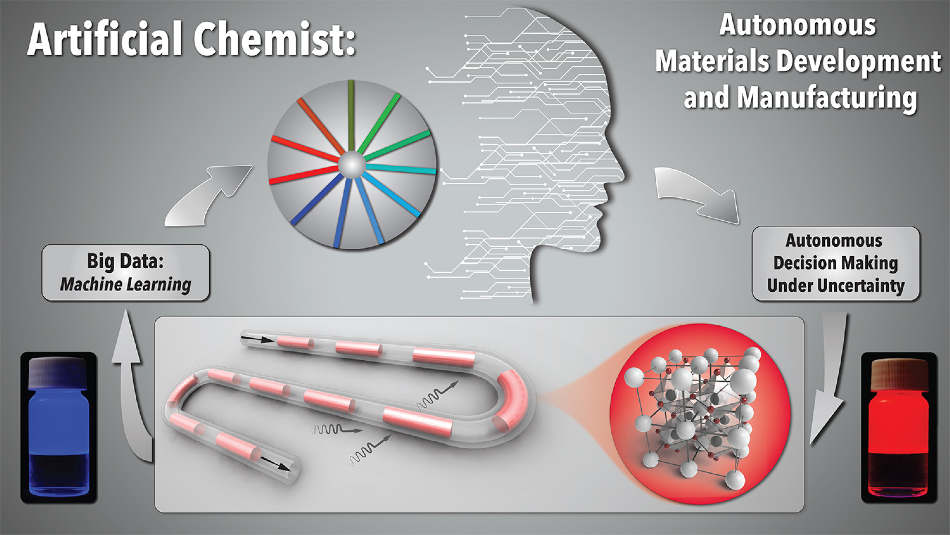Jun 5 2020
A technology named “Artificial Chemist” developed by researchers at North Carolina State University and the University at Buffalo integrates artificial intelligence (AI) and an automated system to carry out chemical reactions to ramp up R&D and manufacture commercially desirable materials.

Image Credit: North Carolina State University.
Through proof-of-principle experiments, the researchers showed that Artificial Chemist has the capability to find and generate the most ideal quantum dots for any color within just 15 minutes. Quantum dots, which are colloidal nanocrystals of semiconductors, are used in applications like LED displays.
But the researchers quickly add that Artificial Chemist can find the ideal material to fulfill any suite of quantifiable properties, and not just quantum dots.
Artificial Chemist is a truly autonomous system that can intelligently navigate through the chemical universe. Currently, Artificial Chemist is designed for solution-processed materials – meaning it works for materials that can be made using liquid chemical precursors. Solution-processed materials include high-value materials such as quantum dots, metal/metal oxide nanoparticles, metal organic frameworks (MOFs), and so on.
Milad Abolhasani, Study Corresponding Author and Assistant Professor of Chemical and Biomolecular Engineering, North Carolina State University
Abolhasani continued, “The Artificial Chemist is similar to a self-driving car, but a self-driving car at least has a finite number of routes to choose from in order to reach its pre-selected destination. With Artificial Chemist, you give it a set of desired parameters, which are the properties you want the final material to have.”
“Artificial Chemist has to figure out everything else, such as what the chemical precursors will be and what the synthetic route will be, while minimizing the consumption of those chemical precursors,” added Abolhasani.
The end result is a fully autonomous materials development technology that not only helps you find the ideal solution-processed material more quickly than any techniques currently in use, but it does so using tiny amounts of chemical precursors. That significantly reduces waste and makes the materials development process much less expensive.
Milad Abolhasani, Study Corresponding Author and Assistant Professor of Chemical and Biomolecular Engineering, North Carolina State University
The Artificial Chemist system includes a “body” for carrying out experiments and sensing the results of the experiments, as well as a “brain” that records the experimental data and uses it to identify what the next experiment will be.
To test their proof-of-principle, the automated Nanocrystal Factory and NanoRobo flow synthesis platforms created in Abolhasani’s lab were integrated into Artificial Chemist’s body. Although it has been shown that the Artificial Chemist system can run 500 quantum dot synthesis experiments in a day, Abolhasani predicts that it could run nearly 1,000.
The brain of Artificial Chemist is an AI program that can characterize the materials produced by the body and use that data to make autonomous decisions on the next set of experimental conditions. Its decisions are based on what it identifies will most effectively take it to the ideal material composition with the preferred properties and performance metrics.
“We tried to mimic the process that humans use when making decisions, but more efficiently,” added Abolhasani.
For instance, Artificial Chemist enables “knowledge transfer,” which implies that it stores data produced from every request it receives, accelerating the process of determining the next candidate material it is tasked with. Simply put, as time passes, Artificial Chemist turns faster and smarter at determining the right material.
For their proof of principle, the researchers investigated nine different policies for the ways in which the AI uses data to identify the next possible experiment. Then, they ran a series of requests, each time prompting Artificial Chemist to determine a quantum dot material that was the most suitable for three different output parameters.
“We found a policy that, even without prior knowledge, could identify the best quantum dot possible within 25 experiments, or about one-and-a-half hours,” stated Abolhasani. “But once Artificial Chemist had prior knowledge—meaning that it had already handled one or more target material requests—it could identify the optimal material for new properties in 10 to 15 minutes.”
We found that Artificial Chemist could also rapidly identify the boundaries of materials properties for a given set of starting chemical precursors, so that chemists and materials scientists do not need to waste their time on exploring different synthesis conditions.
Milad Abolhasani, Study Corresponding Author and Assistant Professor of Chemical and Biomolecular Engineering, North Carolina State University
“I believe autonomous materials R&D enabled by Artificial Chemist can re-shape the future of materials development and manufacturing. I’m now looking for partners to help us transfer the technique from the lab to the industrial sector,” Abolhasani concluded.
The first author of the study is Robert W. Epps, a PhD student at NC State. The co-authors of the paper are NC State undergraduate Michael S. Bowen; NC State PhD students Amanda A. Volk, Kameel Abdel-Latif, and Suyong Han; Kristofer Reyes, an assistant professor at the University at Buffalo; and Aram Amassian, an associate professor of materials science and engineering at NC State.
The study was performed with financial support from a UNC Research Opportunities Initiative grant and from the National Science Foundation, under grant number 1902702.
Journal Reference:
Epps, R.W., et al. (2020) Artificial Chemist: An Autonomous Quantum Dot Synthesis Bot. Advanced Materials. doi.org/10.1002/adma.202001626.